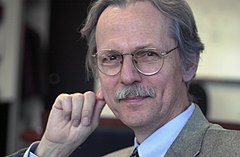Charles R. Alcock
 Charles R. Alcock, 2004 | |
| Państwo działania | |
|---|---|
| Data i miejsce urodzenia | |
| Doktor nauk fizycznych | |
| Specjalność: astrofizyka | |
| Alma Mater | Auckland University California Institute of Technology |
| Doktorat | 1977 – astronomia i fizyka |
| Zatrudnienie | |
| Okres zatrudn. | od sierpnia 2004 roku |
Charles Roger Alcock (ur. 15 czerwca 1951 w Windsorze) – angielsko-nowozelandzki astronom pracujący w Stanach Zjednoczonych, od 2004 roku dyrektor Harvard-Smithsonian Center for Astrophysics w Cambridge (Massachusetts).
Życiorys
Alcock uczył się w Westlake Boys High School w North Shore (Auckland) w latach 1965–1968. Ukończył Auckland University w 1972 roku[1]. Po studiach doktoranckich w California Institute of Technology uzyskał tamże doktorat w 1977 roku. W drugiej połowie lat 70. przebywał na stypendium m.in. w Centrum Astronomicznym im. Mikołaja Kopernika PAN, gdzie współpracował m.in. z Bohdanem Paczyńskim. W latach 1977–1981 pracował w Institute for Advanced Study w Princeton, a następnie jako associate professor fizyki w Massachusetts Institute of Technology w latach 1981–1986, po czym został dyrektorem Institute of Geophysics and Planetary Physics w Lawrence Livermore National Laboratory, piastując to stanowisko w latach 1986–2000. W okresie 2001–2004 pracował na stanowisku Reese W. Flower Professor of Astronomy na University of Pennsylvania[2].
W sierpniu 2004 roku został dyrektorem Harvard-Smithsonian Center for Astrophysics, gdzie zarządza budżetem federalnym wysokości 111 milionów dolarów i kieruje pracą ponad 540 osób zatrudnionych w Smithsonian Astrophysical Observatory i 130 pracowników Harvard College Observatory.
Zainteresowania
Alcock interesuje się masywnymi zwartymi obiektami w halo, kometami i planetoidami. Jest autorem znaczących prac opisujących rolę ciemnej materii w halo Drogi Mlecznej. Jest również szefem projektu (principal investigator) Taiwanese-American Occultation Survey mającego na celu określenie wielkości populacji obiektów znajdujących się w pasie Kuipera[3].
Nagrody i członkostwa
- Alfred P. Sloan Research Fellowship, 1983
- R&D 100 Award, 1993
- E.O. Lawrence Award for Physics, 1996[4]
- University of California Regents’ Lecturer, 1998–1999
- Beatrice M. Tinsley Prize, 2000[1]
Charles R. Alcock w 2001 roku został członkiem National Academy of Sciences. W 2006 roku został członkiem American Academy of Arts and Sciences[5].
Życie prywatne
Charles R. Alcock w latach 70. był mężem Anny Żytkow.
Przypisy
- ↑ a b CV Charlesa R. Alcocka na stronie Center for Astropphysics. [dostęp 2014-11-27].
- ↑ Profil Charlesa R. Alcocka na stronie Harvard University. [dostęp 2014-11-27].
- ↑ TAOS Project. [dostęp 2014-11-27]. [zarchiwizowane z tego adresu (2014-12-04)].
- ↑ Charles Roger Alcock, 1996. The Earnest Orlando Lawrence Award na stronie U.S. Department of Energy. [dostęp 2014-11-27].
- ↑ Book of Members, 1780-2010: Chapter A. American Academy of Arts and Sciences. [dostęp 2014-11-27].
Media użyte na tej stronie
The flag of Navassa Island is simply the United States flag. It does not have a "local" flag or "unofficial" flag; it is an uninhabited island. The version with a profile view was based on Flags of the World and as a fictional design has no status warranting a place on any Wiki. It was made up by a random person with no connection to the island, it has never flown on the island, and it has never received any sort of recognition or validation by any authority. The person quoted on that page has no authority to bestow a flag, "unofficial" or otherwise, on the island.
Autor: Harvard University News Office, Licencja: CC BY-SA 4.0
Dr. Charles Alcock, director of the Harvard-Smithsonian Center for Astrophysics, Cambridge, Mass.

